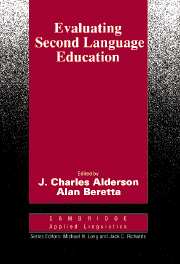Crossref Citations
This Book has been
cited by the following publications. This list is generated based on data provided by Crossref.
Paulston, Christina Bratt
and
McLaughlin, Susanne
1994.
Language-in-Education Policy and Planning.
Annual Review of Applied Linguistics,
Vol. 14,
Issue. ,
p.
53.
Rea-Dickins, Pauline
1994.
Evaluation and English language teaching.
Language Teaching,
Vol. 27,
Issue. 2,
p.
71.
1994.
Editorial.
Language Testing,
Vol. 11,
Issue. 1,
p.
i.
Cenoz, Jasone
and
Lindsay, Diana
1994.
Teaching english in primary school: A project to introduce a third anguage to eight year olds.
Language and Education,
Vol. 8,
Issue. 4,
p.
201.
Cumming, Alister
1996.
IEA's Studies of Language Education: their scope and contributions.
Assessment in Education: Principles, Policy & Practice,
Vol. 3,
Issue. 2,
p.
179.
Mushi, Selina L.P.
1996.
Some general ideas informing second language teaching globally: Obstacles to their utilisation in Tanzania.
Language, Culture and Curriculum,
Vol. 9,
Issue. 2,
p.
133.
Dushku, S
1998.
ELT in Albania: project evaluation and change.
System,
Vol. 26,
Issue. 3,
p.
369.
Frodden, Cristina
and
Lopez, Angela
1998.
University-schools collaboration through the teaching practicum.
Íkala, Revista de Lenguaje y Cultura,
Vol. 3,
Issue. 2,
p.
47.
Lynch, Tony
Yah, Wang Yoon
Anderson, Kenneth
and
Thiyagarajah, Rosy
1999.
Consultancy as Dialogue: Experiences From a Malaysian Esp Project.
RELC Journal,
Vol. 30,
Issue. 1,
p.
62.
Turner, Carolyn
1999.
Book Review: Language program evaluation: theory and practice.
Language Testing,
Vol. 16,
Issue. 3,
p.
394.
Rubiano, Clara Inés
Frodden, Cristina
and
Cardona, Gloría
2000.
The impact of the colombian framework for english (COFE) project: an insiders'perspective.
Íkala, Revista de Lenguaje y Cultura,
Vol. 5,
Issue. 1,
p.
37.
Cadorath, Jill
Harris, Simon
and
Encinas, Fatima
2002.
Training for Distance Teaching through Distance Learning.
Open Learning: The Journal of Open, Distance and e-Learning,
Vol. 17,
Issue. 2,
p.
139.
Ross, Steven J.
2003.
A Diachronic Coherence Model for Language Program Evaluation.
Language Learning,
Vol. 53,
Issue. 1,
p.
1.
Elder, Catherine
2005.
Evaluating the Effectiveness of Heritage Language Education: What Role for Testing?.
International Journal of Bilingual Education and Bilingualism,
Vol. 8,
Issue. 2-3,
p.
196.
Bygate, Martin
2005.
Applied Linguistics: A Pragmatic Discipline, a Generic Discipline?.
Applied Linguistics,
Vol. 26,
Issue. 4,
p.
568.
Chapelle, Carol A.
2007.
Challenges in Evaluation of Innovation: Observations from Technology Research.
Innovation in Language Learning and Teaching,
Vol. 1,
Issue. 1,
p.
30.
Waters, Alan
2009.
Managing innovation in English language education.
Language Teaching,
Vol. 42,
Issue. 4,
p.
421.
Hall, David
and
Knox, John
2009.
Issues in the education of TESOL teachers by distance education.
Distance Education,
Vol. 30,
Issue. 1,
p.
63.
Norris, John M.
2009.
Understanding and improving language education through program evaluation: Introduction to the special issue.
Language Teaching Research,
Vol. 13,
Issue. 1,
p.
7.
Gilmore, Alex
2011.
“I Prefer Not Text”: Developing Japanese Learners’ Communicative Competence with Authentic Materials.
Language Learning,
Vol. 61,
Issue. 3,
p.
786.



